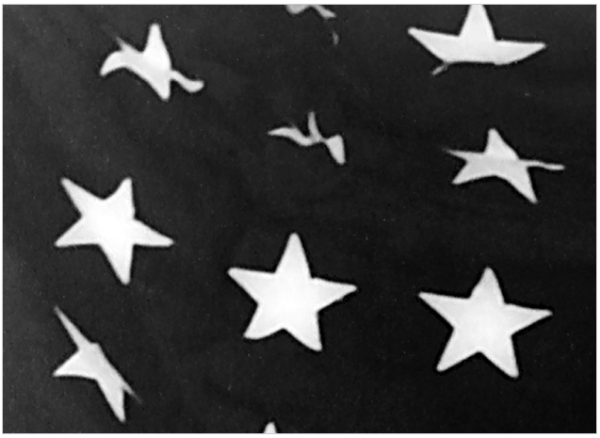
You may have seen our recent Call For Entries on emerging artist zone--but if you were in Greenpoint between Friday, January 20th and Sunday, January 22nd, you may have heard some strange chanting echoing from the 155 Freeman Street locale. No, a new Pagan cult hasn't moved into town (though knowing this city, one actually may have). Rather, the venerable arts organization, Triple Canopy, was celebrating the long anticipated opening of their new location with a three-day reading of Gertrude's Stein's "allegedly unreadable" book, The Making of Americans: Being a History of a Family’s Progress.
A unique christening ritual to be sure, but one befitting a "hub for the exploration of emerging forms and the public spaces constituted around them." Triple Canopy's current issue, "Negative Infinity," includes a project that pits motion studies, industrial capitalism and mental illness against the power of Buster Keaton as well as six other items that are as penetrating as they are unique. Editor Sam Frank filled us in on the details behind the open house extravaganza.
3W's Perrin Drumm: First off, tell us why is Gertrude Stein's The Making of Americans: Being a History of a Family’s Progress "allegedly unreadable?"
Sam Frank: It's very long--nearly 1,000 pages--quite repetitive in a rhythmic way, like minimalist music, but also in an attempt to be exhaustive and describe everyone who could ever exist as completely as possible. Stein was more than interested in the kind of empiricism you get in the sciences, which in one sense are ultimately concerned with complete description and explanation of everything therein. Long and longer sentences and multipage paragraphs, a plot that vanishes for tens of pages at a time. In part it's just a cliché that Stein's unreadable; the easy thing to say if you haven't tried.
PD: Do you think this past weekend proved that statement wrong?
SF: Reading the book out loud for 15 minutes (or 3 hours, in the case of Ariana Reines)--in what way is that reading the book as a whole? And what about listening to someone read for 15 minutes or 3 hours? Is the listener reading The Making of Americans or not? No one stayed the whole time. Did anyone read the book last weekend? Or did everyone read the book? And what about the people who "read" it through our live-tweeting?
PD: We're listening...
SF: One thing that was fascinating was how many different ways of not reading Stein there were, almost as many as there were readers. Some people read it for the rhythm--often the poets--some found the novel in it--often the novelists. Sometimes people's dyslexia surfaced and they swam in the language, flailed in it. People unconsciously normalized the word order and "corrected" words they weren't expecting to those they were. But reading out loud was really a much easier and more joyful thing than sitting down silently with the book. And the last hour was a unison-read from everyone in the room: a bit cultic, a bit cathartic, a physical release. Are all those people going to go home and read the book from page 1? No. But so many people have already said how psyched they are to do it again next year.
PD: What made Triple Canopy choose this as their opening event?
SF: Artists Space and then Paula Cooper Gallery have hosted The Making of Americans marathons over New Year's for a quarter century, through Y2K. Readers ran the gamut of downtown NY types: Fluxus people, John Cage and friends, artists, writers, dancers, musicians. A whole community came together around this book and this reading; and we wanted to see what would happen if we did it a generation later, in a new neighborhood, for a community whose concerns are very similar and very different at once. 155 Freeman isn't big enough to host a party, so we wanted to have an open house instead. We were open for 53 hours and anyone could come by and have a drink or some borscht or stale donuts, read a little and listen a lot. We hope to be a space in Greenpoint (as we try to be on the Web) that's open to our peers and receptive and responsive to history while still being in the present moment. Reading a book from a century ago en masse felt like the right gesture to start it off.
PD: How many readers did you have in all? How long were their "shifts?"
SF: What with the group read at the end, I bet we got up to 200 people total, but certainly more than 150. Most were on for 15 minutes, but some for as short as a page, and a few for more than an hour. (See the complete list of readers)
PD: Assuming you dropped in to see it for yourself, what did you think? Do you know about how the late night/early morning readings went?
SF: Personally, I was there for about eight hours the first night, eighteen hours the next day/night/day, then maybe nine more hours until the end--so, about two-thirds of the time. We finished just before midnight on Sunday, just under fifty-three hours after starting. Besides the TC editors Sarah Resnick and Molly Kleiman, a few other people stayed all night on Friday. At 7 am on Saturday morning, Mary Walling Blackburn and Che Chen sang their section in a kind of Gregorian chant.
People kept coming into this room full of cult members: the Church of Stein, consecrating our new space with half a million words.
PD: Can you give us a sneak peek of some of the upcoming events?
SF: Lots of things coming up, but only a few of them finalized. On Feb. 25, Anna Lundh is doing a performance and lecture drawn from the incredible research that went into "The Tale of the Big Computer."
There's going to be a poetry series of some kind, occasional pop-up exhibits, talks drawn from or feeding into articles in the magazine. A lot will be finalized soon, but for now, here's Program Director Peter Russo on Crisis and Critique:
From February 10–19, Triple Canopy will present Crisis and Critique, an installation project by the Norwegian artist Per-Oskar Leu (call it a "micro-exhibition"). Like much of Leu's work, Crisis and Critique examines the role of the artist during historical moments of upheaval. The centerpiece of his installation is a new video that combines archival recordings of Bertolt Brecht's appearance in 1947 before the House Un-American Activities Committee with several German films from the 1930s and 40s, notably Fritz Lang’s M (1931) and Das Testament des Dr. Mabuse (1933); Brecht’s Kuhle Wampe, oder: Wem gehört die Welt? (1932) and Hangmen Also Die! (1943). We also made a small poster-publication with Leu, available free at the show, that includes an 1933 essay on the role of the artist during economic crisis, by the late German-Jewish artist Otto Freundlich, as well as a diagram of the so-called "Business Plot," a political conspiracy wherein Wall Street allegedly sought to overthrow FDR.
-- Perrin Drumm
 Feb 22, 2012 Tweet
Feb 22, 2012 Tweet 
 Email tagged
Email tagged  Anna Lundh,
Anna Lundh,  Essential Event,
Essential Event,  Events,
Events,  Performance,
Performance,  Triple Canopy
Triple Canopy 



